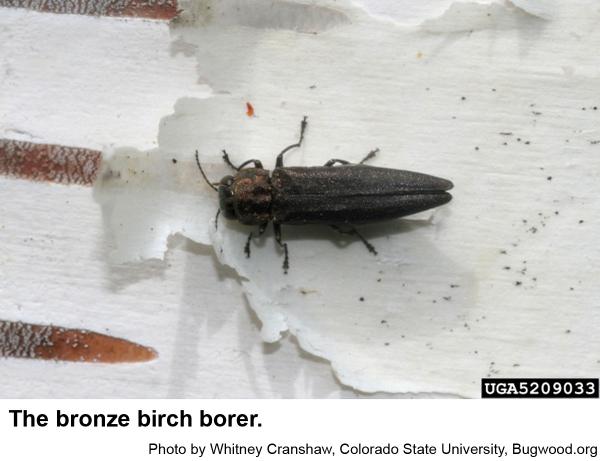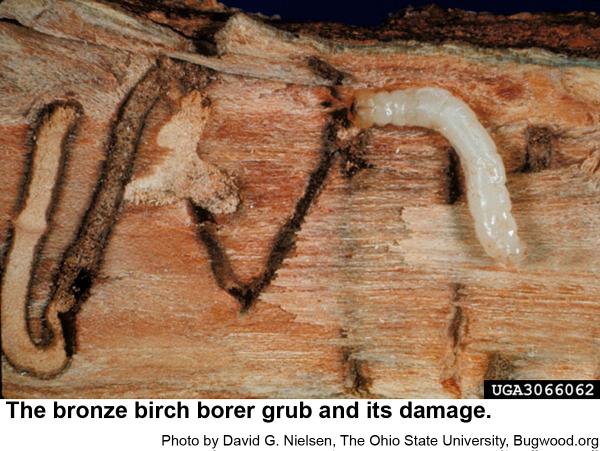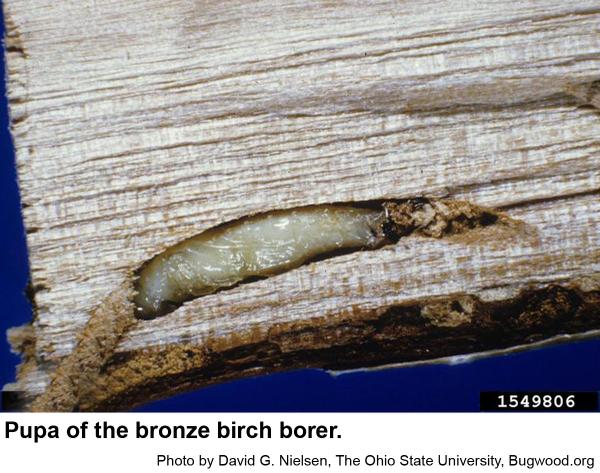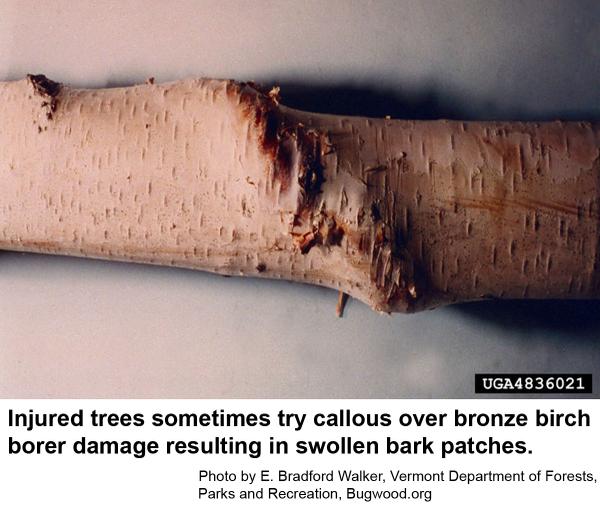Description and Biology
The bronze birch borer, Agrilus anxius, tends to infest hardwoods that are stressed, particularly birches. They are slender, dark, irridescent, usually greenish-bronze beetles up to 1/2 inch long. Mature grubs are very slender, and have a flattened, enlarged area behind its head. Pupae are found in the tunnel grubs excavate and are pale to very dark just before molting. Bronze birch borers overwinter in feeding galleries as grubs that pupate in early spring. Adults appear throughout the summer and lay eggs under bark scales or crevices of the main trunk or branches or even in small niches females chew in the bark. Tiny grubs hatch in about a week and chew through the bark to the phloem tissue where they chew zigzag patterns under the bark as they feed through the growing season. Their tunnels are sometimes 3 inches long or more especially in young trees This girdles the tree from the inside. Mature larvae then overwinter before pupating and emerging as adults the following spring through a "D"-shaped hole. Flatheaded borers are especially destructive to newly planted trees and trees weakened by drought, defoliation, or other adverse factors. Most borers do not attack perfectly healthy trees.
Host Plants
Bronze birch borers attack all species of birches. Fortunately for us, river birch, our most abundant birch in North Carolina, has low susceptibility to this pest. However, white birches, paper birch, and other species exotic to our state are highly susceptible to these borers. This species also infests beech. The larvae of the bronze birch borer feed in the phloem tissue, reducing transport from the canopy to the roots. Infested trees often die back from the upper crown.
Residential Recommendations
Watering during dry spells and mulching to moderate soil temperatures should help susceptible trees avoid bronze birch borers. Avoid applying fertilizer around birches as heavily fertilized plants are probably more susceptible to these borers. Don't prune during the growing season as female borers are attracted to fresh wounds. Most of the pyrethroid insecticides labeled for landscape use should prevent borer damage by repelling female bronze birch borers or killing their grubs upon hatching and trying to bore through pyrethroid-contaminated bark.
Other Resources
- Bronze Birch Borer, Agrilus anxius Gory. Hoover, G. A., Sr. 2002. The Pennsylvania State University Department of Entomology.
- Bronze Birch Borer. Childs, R. 2011. UMass Extension, Landscape, Nursery & Urban Forestry Program.
- The Bronze Birch Borer and Its Management. Wawrzynski, R. P., et al. 1997 (revised). University of Minnesota Extension Service FS-01417.
- Extension Plant Pathology Publications and Factsheets
- Horticultural Science Publications
- North Carolina Agricultural Chemicals Manual
For assistance with a specific problem, contact your local N.C. Cooperative Extension center
This Factsheet has not been peer reviewed.
Publication date: May 11, 2019
Revised: Feb. 20, 2024
Recommendations for the use of agricultural chemicals are included in this publication as a convenience to the reader. The use of brand names and any mention or listing of commercial products or services in this publication does not imply endorsement by NC State University or N.C. A&T State University nor discrimination against similar products or services not mentioned. Individuals who use agricultural chemicals are responsible for ensuring that the intended use complies with current regulations and conforms to the product label. Be sure to obtain current information about usage regulations and examine a current product label before applying any chemical. For assistance, contact your local N.C. Cooperative Extension county center.
N.C. Cooperative Extension prohibits discrimination and harassment regardless of age, color, disability, family and marital status, gender identity, national origin, political beliefs, race, religion, sex (including pregnancy), sexual orientation and veteran status.




